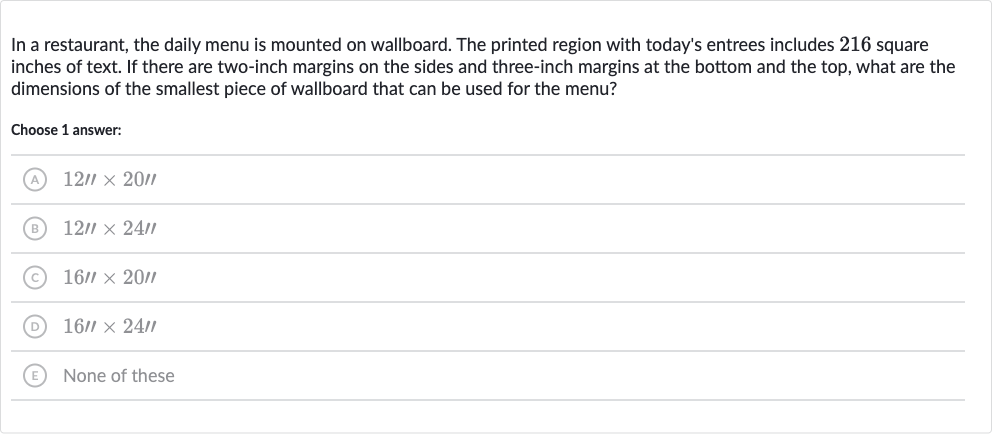AI tutor
Welcome to Bytelearn!
Let’s check out your problem:

In a restaurant, the daily menu is mounted on wallboard. The printed region with today's entrees includes square inches of text. If there are two-inch margins on the sides and three-inch margins at the bottom and the top, what are the dimensions of the smallest piece of wallboard that can be used for the menu?Choose answer:(A) (B) (C) (D) (E) None of these
Full solution
Q. In a restaurant, the daily menu is mounted on wallboard. The printed region with today's entrees includes square inches of text. If there are two-inch margins on the sides and three-inch margins at the bottom and the top, what are the dimensions of the smallest piece of wallboard that can be used for the menu?Choose answer:(A) (B) (C) (D) (E) None of these
- Calculate Side Margins: Calculate the total width of the margins on the sides. There are two-inch margins on each side, so that's inches + inches = inches total for the side margins.
- Calculate Top and Bottom Margins: Calculate the total height of the margins at the bottom and the top. There are three-inch margins at the bottom and the top, so that's inches + inches = inches total for the top and bottom margins.
- Find Width with Side Margins: Find the width of the printed region plus the side margins. We don't know the width yet, but we know the total area of the text is square inches. Let's call the width of the printed region . The total width of the wallboard will be inches.
- Find Height with Top and Bottom Margins: Find the height of the printed region plus the top and bottom margins. We don't know the height yet, but let's call the height of the printed region . The total height of the wallboard will be inches.
- Write Area Equation: Write down the equation for the area of the printed region. The area of the printed region is square inches.
- Find Dimensions Factors: Now we need to find the dimensions and that will give us the area of square inches. We can try the factors of to see which pair of factors, when increased by the margins, will match one of the answer choices. The factors of are , , , , , , .
- Add Margins to Factors: Add the margins to each pair of factors to see which one fits an answer choice. For example, for the pair , the total dimensions with margins would be inches by inches, which is inches by inches.
- Check Answer Choices: Check if the dimensions inches by inches match any of the answer choices. It matches answer choice (D) .
- Choose Correct Answer: Choose answer choice as the correct answer.
